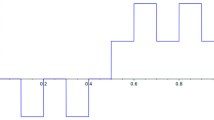Abstract.
Let F be a local field, \( \psi \) a nontrivial unitary additive character of F, and V a finite dimensional vector space over F. Let us say that a complex function on V is elementary if it has the form \( g(x) = C\psi(Q(x))\prod^{k}_{j = 1}\chi_j(P_j(x)), x \in V \), where \( C \in \mathbb{C} \), Q is a rational function (the phase function), \( P_j \) are polynomials, and \( \chi_j \) multiplicative characters of F. For generic \( \chi_j \), this function canonically extends to a distribution on V (if char(F) = 0). Occasionally, the Fourier transform of an elementary function is also an elementary function (the basic example is the Gaussian integral: k = 0, Q is a nondegenerate quadratic form). It is interesting to determine when exactly this happens. This question is the main subject of our study. In the first part of this paper we show that for \( F = \mathbb{R} \) or \( \mathbb{C} \), if the Fourier transform of an elementary function \( g \neq 0 \) with phase function -Q such that \( \det d^2Q \neq 0 \) is another elementary function \( g^* \) with phase function \( Q^* \), then \( Q^* \) is the Legendre transform of Q (the "semiclassical condition"). We study properties and examples of phase functions satisfying this condition, and give a classification of phase functions such that both Q and \( Q^* \) are of the form f(x)/t, where f is a homogeneous cubic polynomial and t is an additional variable (this is one of the simplest possible situations). Unexpectedly, the proof uses Zak's classification theorem for Severi varieties.¶ In the second part of the paper we give a necessary and sufficient condition for an elementary function to have an elementary Fourier transform (in an appropriate "weak" sense) and explicit formulas for such Fourier transforms in the case when Q and \( P_j \) are monomials, over any local field F. We also describe a generalization of these results to the case of monomials of norms of finite extensions of F. Finally, we generalize some of the above results (including Fourier integration formulas) to the case when \( F = \mathbb{C} \) and Q comes from a prehomogeneous vector space.
Similar content being viewed by others
Author information
Authors and Affiliations
Rights and permissions
About this article
Cite this article
Etingof, P., Kazhdan, D. & Polishchuk, A. When is the Fourier transform of an elementary function elementary? . Sel. math., New ser. 8, 27 (2002). https://doi.org/10.1007/s00029-002-8101-7
DOI: https://doi.org/10.1007/s00029-002-8101-7




